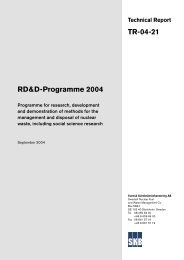Read/Download - SKB
Read/Download - SKB
Read/Download - SKB
- No tags were found...
You also want an ePaper? Increase the reach of your titles
YUMPU automatically turns print PDFs into web optimized ePapers that Google loves.
1200Rotation Speed1000800rpm6004002000100 200 300 400 500 600 700 800 900 1000Length (m)Figure 5-8. Rotation speed versus borehole length during drilling of borehole KFM06C.5.4.4 Registration and sampling of flushing water and return waterFlushing water and return water flow rate – water balanceAs borehole KFM06C is of <strong>SKB</strong> chemical type, it is important to estimate the amount offlushing water pumped into the borehole during drilling as well as the amount of return waterrecovered to permit a water balance calculation. A flow gauge in the measurement station,registered the flushing water flow rate, see Figure 3-3. The return water was measured byanother flow meter, mounted on-line with the discharge pipeline, see Figures 3-3 and 3-6.However, the return water is normally a mixture of flushing water and groundwater from theformation penetrated by the borehole. In order to estimate the amount of remaining flushingwater in the formation and in the borehole after drilling, one must also study the content of theUranine tracer in the flushing water and return water. This enables a mass balance calculationfrom which the flushing water content in the borehole can be determined.Figure 5-9 illustrates the accumulated volume of flushing water and return water versus timeduring core drilling, while Figure 5-10 displays the accumulated volumes of flushing waterand return water from the entire drilling period, giving a return water/flushing water quotient of1.69 [1,861 L/1,100 L] (results from Uranine measurements are presented in the next section).However, in Figure 5-9 a loss of flushing water at shallow depths in the borehole is observed,as well as a significant excess of return water at depths exceeding c. 350 m, May 11 th 2005.This reflects the fact that when the drill bit position is close to water conductive fractures in theborehole, flushing water is forced into these fractures, because the flushing water pressure muchexceeds that of the formation. When the drill bit has passed this section, the pressure gradientwill eventually be reversed due to the air–lift pumping in the upper part of the borehole. If noother highly water conductive fractures are penetrated, where flushing water losses may occur,larger amounts of return water (groundwater and flushing water) are then extracted from theborehole than flushing water is supplied to it.Figure 5-11 illustrates the variations of flushing water and return water flow rate together withvariations of the groundwater table during core drilling of borehole KFM06C. The return waterflow rate depends on the inflow into the borehole, as well as on the draw-down (accomplishedby the air-lift pumping). To cool the drill bit and keep the borehole bottom clean, drilling usuallyrequires a flushing water flow rate of c. 35 L/min. However, immediately after a core recovery,a temporarily higher flushing water flow rate is often applied.36
















